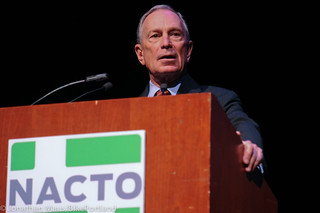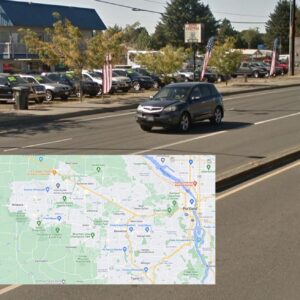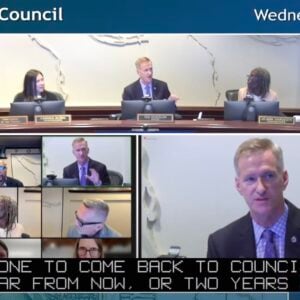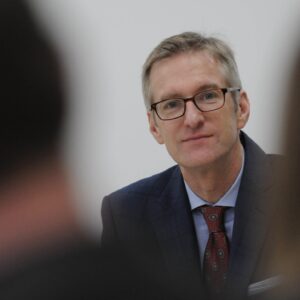
have played major role in New York City’s success.
(Photos © J. Maus/BikePortland)
New York City Mayor Michael Bloomberg spoke at the closing plenary of the NACTO Designing Cities Conference today. At an event held at the Skirball Center for the Performing Arts on the campus of NYU in Manhattan, Bloomberg shared his perspective on the role transportation plays in his city’s success.
Bloomberg was introduced by the Commissioner of New York City’s Department of Transportation (and President of NACTO), Janette Sadik-Khan. She hailed Bloomberg’s leadership, saying that, “It’s not an exaggeration to say, the impact he’s had on New York, the nation, and the world will be felt for a long time after he’s left City Hall.”
made possible by:
- Planet Bike
- Lancaster Engineering
- Readers like you!
Under his three term, 10-year run as mayor, Bloomberg has overseen unprecedented changes in how the city uses its public spaces. Sadik-Khan pointed out that under his administration, one-fifth of the city’s land area has been rezoned, 130 new acres of parks have been added, streets are 40% safer, bike commuting has quadrupled (thanks to the addition of 300 new miles of bike lanes), and 52 pedestrian plazas encompassing 22 acres of new public space have been added to communities across the city.
“His leadership,” Sadik-Khan added, “is why we were able to close Times Square to traffic in the middle of a re-election campaign when many recommended against it.”
Bloomberg has succeeded because he “embraces change and innovation and he’s not scared of poll numbers.”
“His leadership is why were were able to close Times Square to traffic in the middle of a re-election campaign when many recommended against it.”
— Janette Sadik-Khan, NYC DOT Commissioner
Once on stage, Bloomberg did his best to sell the crowd on New York City. He rattled off a list of accomplishments and said the transportation system reforms he’s championed are a key part of making them happen.
About the massive project to reclaim Broadway Blvd/Times Square for people, Bloomberg said, jokingly, that it was “Harder to do than the smoking ban.”
Steering the city through such profound changes to public space has required Bloomberg and his staff to find a delicate balance in how they work with the public to implement the projects. Addressing that challenge, Bloomberg said, “There are people who don’t like any change whatsoever, and there are people who always want another study; but by and large, people want progress as long as it’s done carefully and thoughtfully — even if they don’t think it’s the right thing to do.”
Bloomberg credited the “changes to the roads” as a key reason why the city is doing well. “By putting in bicycle lanes and closing some of these streets for pedestrians… I’ve tried to explain to people that streets are there to transport people,” he said, “they’re not necessarily there for cars.”
“There are a lot of ways to transport people. In fact, one of the original ways was walking; so we’ve come full circle here.”
With the release by NYC DOT this week of a report showing the economic impact of their street projects, Bloomberg wove the economic case into his speech. “Talk to merchants everywhere we’ve put protected bicycle lanes [and pedestrian plazas]… They will tell you that business is dramatically better than it was before.”
“… Streets are there to transport people, they’re not necessarily there for cars.”
— Mayor Bloomberg
Bloomberg called New York City’s legacy of mega-highway building by former DOT Commissioner Robert Moses a “mistake” because “we bulldozed neighborhoods.”
With the mistakes of the past fading from view, Bloomberg seems to understand the direct link between how streets are used and whether or not a city succeeds. “We’re using the streets in ways they had not been used in a long time,” he said, “Cyclists and pedestrians and bus riders are as important — if not, I would argue more important — than automobile riders.”
While he acknowledged that bike lanes “are always controversial” he defended them by noting that, “more and more people are using them.”
Looking ahead, Bloomberg said he has no plans of letting naysayers or controversies stop the progress. “Transportation… it’s not sexy and it certainly invites controversy,” he said, but added, “We’ve just got to keep developing, keep building, sensibly, with some plans and community involvement; but not stopping.”
“You’ve got to build for tomorrow and you can’t just let the preservationists or the ‘NIMBY people’ as we call them, stop everything. And we’re not going to let them do that… At least for the next 432 days; but who’s counting?”
——
A lot of people are counting. One of the most persistent conversations I’ve been having here is whether or not all the work this dynamic duo of Bloomberg and Sadik-Khan have done will be stymied once Bloomberg’s reign is over. I don’t think it will; but I’ll leave more thoughts about that for a separate post.
— This post is part of my ongoing New York City coverage. I’m here for a week to cover the NACTO Designing Cities conference and the city’s bike culture in general. This special reporting trip was made possible by Planet Bike, Lancaster Engineering, and by readers like you. Thank you! You can find all my New York City coverage here.








Thanks for reading.
BikePortland has served this community with independent community journalism since 2005. We rely on subscriptions from readers like you to survive. Your financial support is vital in keeping this valuable resource alive and well.
Please subscribe today to strengthen and expand our work.
Intriguing that it is apparently easier for a NY mayor to dismiss cars categorically and give Times Square back to the people than to allow protesters to remain in Zuccotti Park.
Not to mention calling Robert Moses’ legacy a mistake.
It’s a density thing. When the usual mess is gridlock, making changes is easier because everyone is looking for a solution. Since doing things the same way hasn’t been working, new ideas get more traction.
If only Occupy Portland understood land use and community building through reclamation street space as well as New Yorkers.
Bloomberg 2016?
if he wants it, he will buy it
Will there be a video of this or any of the other talks?
Will Bloomberg’s cops no longer assault bicyclists? http://www.youtube.com/watch?v=EUaok48ZYDw
I think bloomberg has about as much control over the NYPD as any mayor has over their police force in the US, which is to say none. Sam is making some progress but I think it will all be erased when he leaves and we will be right back where we started in Portland.
I’m having trouble with your logical process: a mayor has no real effect on their police force so our mayor will have an effect by leaving?
Or was it that he actually did have some control over the PPD?
sadik-khan for mayor?
Worrying about what the next mayor will do is a valid concern:
“When I become mayor, you know what I’m going to spend my first year doing? I’m going to have a bunch of ribbon-cuttings tearing out your fucking bike lanes.” —Congressman Anthony Weiner to frenemy Mayor Bloomberg, during a recent dinner at which beef was served, in their few minutes of cordial man-to-man conversation.